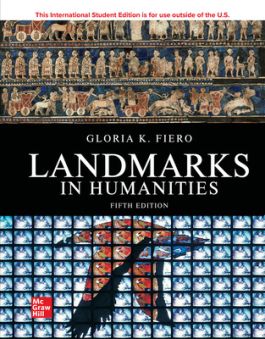Landmarks in Humanities ISE
1260579204
·
9781260579208
All travelers appreciate a personal guide. For humanities students, LANDMARKS provides a chronological journey through the history of culture in one semester. Focusing on prominent landmarks from prehistory to the present, LANDMARKS introduces studen…
Read More
Request Review Access
After purchasing your eBook, login to the McGraw Hill Bookshelf website and redeem the access code from your order confirmation email.
- Access your eBook online or offline
- Easily highlight and take notes
- Fully searchable content
- Syncs across platforms
NOTE: eBook purchase does not include Connect homework or adaptive SmartBook assignments
1 Origins: The First Civilizations
2 Classicism: The Greek Legacy
3 Empire: The Power and Glory of Rome
4 Revelation: The Flowering of World Religions
5 Synthesis: The Rise of the West
6 Christendom: Europe in the Age of Faith
7 Rebirth: The Age of the Renaissance
8 Reform: The Northern Renaissance and the Reformation
9 Encounter: European Outreach and Expansion
10 Baroque: Piety and Extravagance
11 Enlightenment: Science and the New Learning
12 Romanticism: Nature, Passion, and the Sublime
13 Materialism: The Industrial Era and the Urban Scene
14 Modernism: The Assault on Tradition
15 Globalism: Information, Communication, and the Digital Revolution
Glossary
Index
2 Classicism: The Greek Legacy
3 Empire: The Power and Glory of Rome
4 Revelation: The Flowering of World Religions
5 Synthesis: The Rise of the West
6 Christendom: Europe in the Age of Faith
7 Rebirth: The Age of the Renaissance
8 Reform: The Northern Renaissance and the Reformation
9 Encounter: European Outreach and Expansion
10 Baroque: Piety and Extravagance
11 Enlightenment: Science and the New Learning
12 Romanticism: Nature, Passion, and the Sublime
13 Materialism: The Industrial Era and the Urban Scene
14 Modernism: The Assault on Tradition
15 Globalism: Information, Communication, and the Digital Revolution
Glossary
Index
All travelers appreciate a personal guide. For humanities students, LANDMARKS provides a chronological journey through the history of culture in one semester. Focusing on prominent landmarks from prehistory to the present, LANDMARKS introduces students to the creative endeavors of the human imagination and to the prominent ideas and issues that have shaped the course and character of the world’s cultures. The landmarks that mark this journey are the great works of their place and time; they have been transmitted from generation to generation as a living legacy. Understanding that a global humanities course is taught in varying ways, Gloria Fiero redefines the discipline for greater flexibility via a variety of personalized digital tools that meet and refine your teaching goals in less time. Enhanced by McGraw-Hill Education’s SmartBook 2.0, Fiero delivers a learning experience tailored to the needs of each institution, instructor, and student. With the ability to incorporate new extended readings, streaming music, and artwork, LANDMARKS renews the understanding of the relationship between world cultures and humankind’s creative legacy.
LANDMARKS is unique in several ways:
- It is interdisciplinary: it explores the interrelationship of various modes of expression - art, music, literature - as they work to create, define, and reflect the unique culture of a given time and place.
- It is thematic: each chapter advances a key idea, presented in the chapter title and explained in the introductory paragraph. The key idea offers a context for individual landmarks as they unfold chronologically. For instance, Chapter 1 (“Origins: The First Civilizations”) surveys our earliest cultures, emphasizing human strategies for survival and communal life; Chapter 14 (“Modernism: The Assault on Tradition”) considers the radical rejection of conventional values and styles that revolutionized early twentieth-century culture.
- It is selective: some landmarks have been chosen for their universality, some for their singular beauty, and some for their iconic or symbolic value. Certain landmarks - the Statue of Liberty, the Mona Lisa, the sonnets of Shakespeare - meet more than one of these criteria. The author’s choice of landmarks may differ from those of other individuals, and readers may wish to add landmarks of their own.
LANDMARKS is unique in several ways:
- It is interdisciplinary: it explores the interrelationship of various modes of expression - art, music, literature - as they work to create, define, and reflect the unique culture of a given time and place.
- It is thematic: each chapter advances a key idea, presented in the chapter title and explained in the introductory paragraph. The key idea offers a context for individual landmarks as they unfold chronologically. For instance, Chapter 1 (“Origins: The First Civilizations”) surveys our earliest cultures, emphasizing human strategies for survival and communal life; Chapter 14 (“Modernism: The Assault on Tradition”) considers the radical rejection of conventional values and styles that revolutionized early twentieth-century culture.
- It is selective: some landmarks have been chosen for their universality, some for their singular beauty, and some for their iconic or symbolic value. Certain landmarks - the Statue of Liberty, the Mona Lisa, the sonnets of Shakespeare - meet more than one of these criteria. The author’s choice of landmarks may differ from those of other individuals, and readers may wish to add landmarks of their own.

